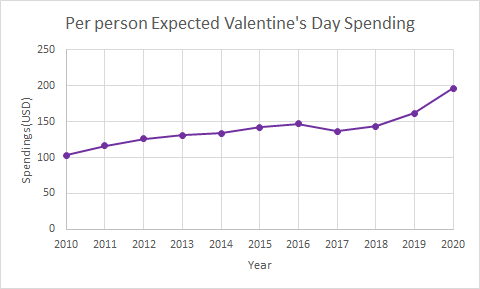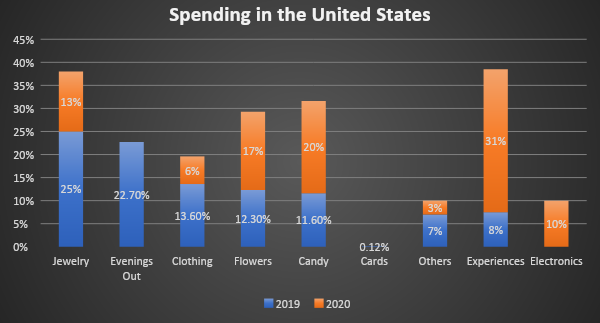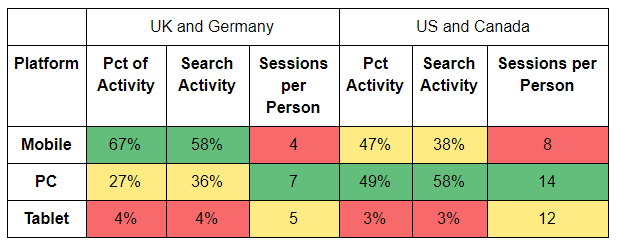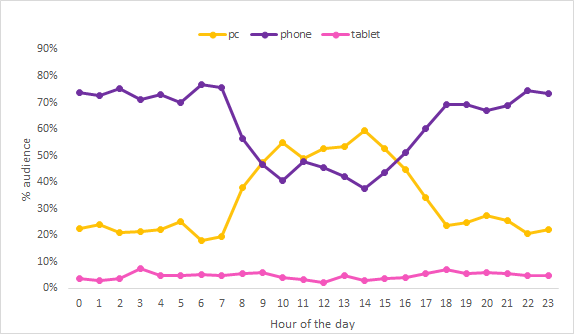As February enters full swing, another Valentine’s Day is around the corner. And with an estimated 30% increase in consumer spending around the special day expected this year, it’s not hard to see why marketers around the globe have fallen in love with the event as well.
Although interest among P18-24 for Valentine’s Day has decreased compared to last year, the elevated per-person consumer spending has managed to increase consistently year-over-year, with the expected per-person spend to increase 21% this year, to more than $190.

As the demographics around Valentine’s Day shift, there’s a definite need for marketers to adjust their strategies and think about how they’re setting priorities for their campaigns. As interest among P18-35 continues to decline (and interest among P35+ increases), advertisers may want to consider how they’re driving not just sales, but sales and engagement among younger consumers.
Gifting habits are changing
Demographics aren’t the only thing changing about Valentine’s Day: Apart from buying gifts for significant others, gift purchases are on the rise for other loved ones, including parents, children, best friends, and even pets. Last year only half of gifts purchased for Valentine’s Day were for significant others or spouses. People buying gifts for pets spent more than $30 USD on average.

Valentine’s Day Spending
Valentine’s Day isn’t just about gifts; consumers also spend heavily on events and experiences spent with a loved one. In prior years, we’ve observed average foot traffic increases of 17% at fine dining restaurants in the United States on Valentine’s Day (compared to a 23% decline in visits to bars/restaurants) in urban areas, with couples accounting for a greater share of visits (single people were more likely to hit the bar). Though not all experiences happen outside the home - with the growing influence of OTT viewing, almost every OTT platform is looking to either launch new rom-com content or leverage existing content libraries to drive engagement during the week, creating more opportunities for advertisers on ad-supported channels and services.
Among those looking to buy gifts, customization has become a bigger point of interest: Consumer research around DIY gifting has increased 7% over 2019 as we enter the week of Valentine’s Day and is likely to increase during the week. Custom printed mugs and accessories like matching rings are among the most-searched customized gift items.
Changing Research Trends
In the weeks leading up to Valentine's Day, there is a 13x increase in the search interest and demand for holiday gifts and accessories, with over 300 million consumers around the world looking to buy gifts for their loved ones. Though a very high proportion of this research occurs within a few days of Valentine’s Day, over the years the amount and duration of pre-event research have grown considerably. In a trend that we’ve observed across the US, UK, Canada, and Germany, 1 in 10 Valentine’s Day shoppers now starts researching gifts before New Year’s.
A growing percentage of Valentine’s Day shopping and research now happens on mobile platforms and devices. Across Europe, more than two out of three Valentine’s Day-related searches occurred on a mobile devices. Even among North American audiences (US + Canada), almost half of this activity came from mobile devices, and made more searches per person compared to Europe.
Research behavior by platforms

For those people spending the most on Valentine’s Day, and searching for the most expensive gifts (travel, jewelry, luxury items, etc.), research was a much bigger factor: Shoppers in this category spent nearly 3x longer researching expensive gifts compared to lose buying low-budget items. This was something we saw across all four of our observed regions (US, UK, Canada, German), with big-ticket item buyers spending an average of 13 sessions searching for and researching gift options compared to those buying cheaper items.
When conducting this research, the bulk of mobile activity happens in the early morning and late evenings, while desktop activity happens during the day. The actual buying and shopping tends to happen in early mornings or evenings, when people are at home.
V-day research temporal trends, by device types

Connecting the Dots
With billions of dollars of retail spend on the line, Valentine’s Day presents marketers with an opportunity to boost their bottom lines and drive early momentum in the year. But with the variety of macro and micro factors that can influence a person’s research and decisions, marketers will need to be smart about how they devise campaigns that can reach shoppers and researchers in the right channels across multiple platforms. And once they’ve done that, they’ll need the right measurement tools in place to make sure they’re capturing consumer action and closing the loop.



